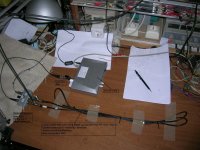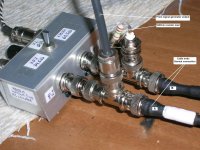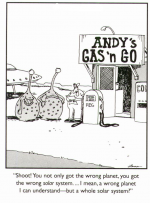Ford determined some time ago that 10% symmetrical clipping distortion was about the threshold for most automotive audio to have people complaining, and it made the bass a lot louder. Since a lot of the chip amps were made for car audio the manufacturers adopted the 10% spec.And why do the electronic companies insist on showing distortion ratings at 10% distortion for there monolithic amplifier chips? Who wants to look at that when you are designing a real amplifier circuit? They make is a pain to find the 1% ratings many times, seems rather silly if you aren't advertising to some dumb a*s consumer looking to make their car license plate rattle.
Harman automotive amps had limiters, and it was sometimes tricky to make them have 10% distortion in limiting, particularly when the supply voltage was changing.
Some of the Japanese chipmakers went further and gave a number for a square wave output!
What I am not historically informed on is where the "PMPO" ratings came from. One used to see these silly powered speakers with preposterous power ratings. They were powered from teeny wall warts. Now the low duty cycle of real audio does help you a lot here, but there are limits.
Now most products that I work on or with use 1% onset-of-clipping as the criterion for power ratings. Sometimes less than that.
Kindhornman --- I got it. But it does depend on the connection/connectors used with the cable and equipment connectors, too.
🙂
THx-RNMarsh
🙂
THx-RNMarsh
Jacco,
I don't often convert from English liquid measure to metric units, we do have just about everything I can think of marked in both units though. When I am working in distances I just have to remember 25.4:1 when going back and forth between inches and mm, not to difficult really once you get used to it. I have to do it all the time so it is second nature at this point. When I'm driving my car it always goes much faster in kilometers per hour! I still have to look at a cheat sheet for GD&T dimensioning but I'll get it down.
quick crib for mph/kph conversion is the fibonnacci series, 20mph=30kph, 30mph=50kph, 50mph=80kph etc, good up to licence threatening speeds.
There are two kinds of countries in the world, those that use the metric system, and those that have been to the moon.
All good fortune,
Chris
All good fortune,
Chris
There are two kinds of countries in the world, those that use the metric system, and those that have been to the moon.
All good fortune,
Chris
You should google Pokrovsky, and to spare you some further time here a 24 FPS video.
https://www.youtube.com/watch?v=zwfRR9nD6lM
Simon7000 --- I got it. But it does depend on the connection/connectors used with the cable and equipment connectors, too.
🙂
THx-RNMarsh
Error on #83862... meant Simon7000
One more time dunno for the US but here a bottle of whisky is marked either 0.75L or 750mL given that 1mL (milli Litre) = 1cm3, and so is every liquid that is less than 1 litre like aluminium packed coke wich has 330mL marked on the can.
Yes, wine is sold here mostly in 750s, with a few 375s and 1.5 (magnum).
Cubic inches = late 60's American muscle cars (426, 427, 428, 429, and 454), when men were men and Tesla was a coil.
Last edited:
Several decades ago, PopTronics magazine had an article about what tools you needed in your kit. Tools like a 1/4inch (6.3mm) wrench.Dan,
I've run into that on some metric sized equipment, you look at a weird dimension and wonder why the value is such a strange number and then you realize it is a fractional inch equivalent! Been there done that.
Kindhornman --- I got it. But it does depend on the connection/connectors used with the cable and equipment connectors, too.
🙂
THx-RNMarsh
It seems to be about 90% connectors it is the rest where it gets interesting.
RNM,
Not sure where I was making a comment that you are referring to? See you correction, wasn't me.
Wrinkle,
I didn't think it was an exactly 1.5:1 ratio of kilometers to miles. I think that is close but off enough to get you a ticket. I looked it is 1.6:1, still something I could calculate in my head.
Not sure where I was making a comment that you are referring to? See you correction, wasn't me.
Wrinkle,
I didn't think it was an exactly 1.5:1 ratio of kilometers to miles. I think that is close but off enough to get you a ticket. I looked it is 1.6:1, still something I could calculate in my head.
Last edited:
It seems to be about 90% connectors it is the rest where it gets interesting.
It turns out that heat can affect connections. The process of unsoldering a wire from a connector and turning it around without removing the connectors, as I think you said was something you tried, could perhaps change connector behavior just from the heat cycling of soldering. Maybe something to rule out?
1.609344, given the 25.4mm/inch ratio (which I believe is exact).RNM,
Not sure where I was making a comment that you are referring to? See you correction, wasn't me.
Wrinkle,
I didn't think it was an exactly 1.5:1 ratio of kilometers to miles. I think that is close but off enough to get you a ticket. I looked it is 1.6:1, still something I could calculate in my head.
Brad,
Don't think I could do the math while traveling down the road with 1.609344 x mph but I could do 1.6 easy enough. Hopefully they still give you the 3mph error here in California for speedo error.
Don't think I could do the math while traveling down the road with 1.609344 x mph but I could do 1.6 easy enough. Hopefully they still give you the 3mph error here in California for speedo error.
The ratio changes with each pair of numbers in the sequence, 50mph 80 kph is 1.6, whilst the true ratio is nearer 1.63, and 50:30 is 1.66666, again close enough to keep you out of troubleRNM,
Not sure where I was making a comment that you are referring to? See you correction, wasn't me.
Wrinkle,
I didn't think it was an exactly 1.5:1 ratio of kilometers to miles. I think that is close but off enough to get you a ticket. I looked it is 1.6:1, still something I could calculate in my head.
- Status
- Not open for further replies.
- Home
- Member Areas
- The Lounge
- John Curl's Blowtorch preamplifier part II





